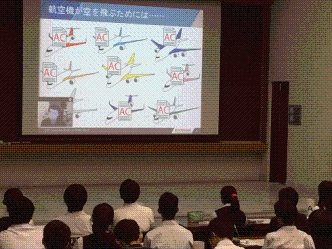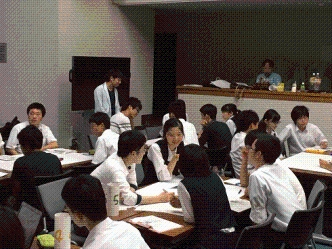Boeing Higher Education Program Inspires Next Generation of Engineers

Date of activity: August 20, 2015
On Thursday, August 20th, 25 students from five high schools in Saitama Prefecture accompanied by 10 teachers gathered at Hongo Campus to discuss their own versions of future aircraft.
This was a part of the 5th Boeing High School and University Collaboration Course. This Course, supported by the Boeing Company’s Boeing Higher Education Program, has been held by the University of Tokyo since 2013 and aims to develop leading scientists and engineers of the future. The key characteristic of the course is in how the courses are designed: the courses are designed based on high schools’ demands for courses that emphasize learning after university entrance exams, and are made so that they are not merely a unilateral communication of the University’s resources to the students. The topic discussed in this course was aeronautics. With the main topic being aeronautics, the course was organized by the Division of University Corporate Relations, the Department of Aeronautics and Astronautics, and the Global Center for Innovation in Engineering Education.
The course started off with an opening speech by Prof. S. Suzuki (Dept. of Aeronautics and Astronautics; also leader of the Course). The course was then followed by an online question and answer session with a Japanese engineer currently developing a new Boeing aircraft in Seattle, WA, a tour of laboratories in the Dept. of Aeronautics and Astronautics, and group work where the high school students discussed and presented their own versions of future aircraft. Some of the topics discussed during the question and answer session were: what made the engineer pursue a career in the aircraft industry, and the advantages of working abroad. During the lab tour, high school students visited labs majoring in four basic aspects of aeronautics: aerodynamics, structures and materials, propulsion, and control. The experiments and explanations during the lab tour were carefully planned out so that they built on ideas learned during science classes in high school. During the group work, the high school students combined what they learned during the lab tour using the jigsaw method, and with some help from faculty members, came up with extremely unique ideas. The groups then presented their ideas, and voted for the best idea.
The course, by focusing on the relationship between research at the University, society, and high school education, was successful in cultivating an interest in engineering within students, especially within those who had not been so enthusiastic about engineering previously. A comparison of questionnaires taken before and after the course clearly showed this. The average score given for “interest in engineering” (with 5 as highest and 1 as lowest) rose from 4.5 to 4.6 for male students, whilst the average score for female students leapt from 3.8 to 4.8.

Online Q&A Session from Seattle 
Group Discussion for Future Aircraft







